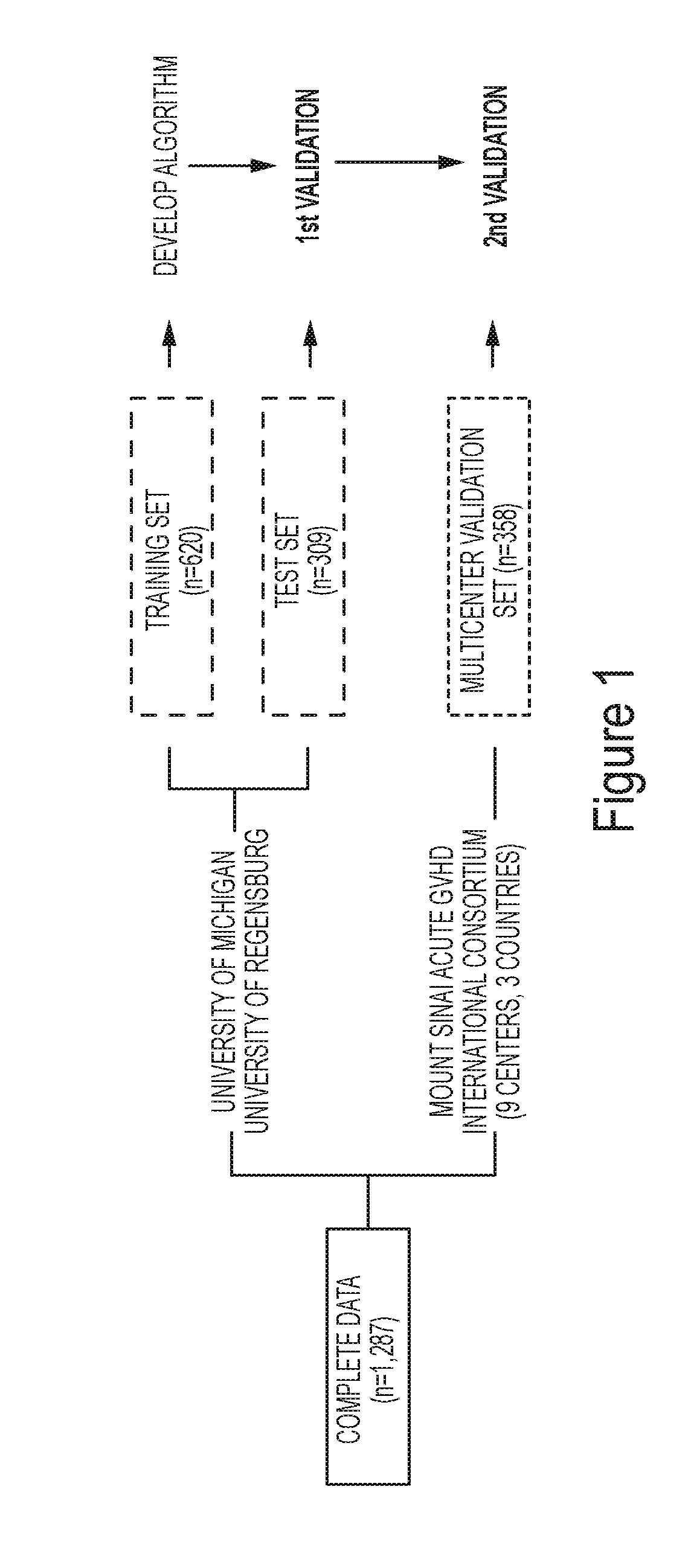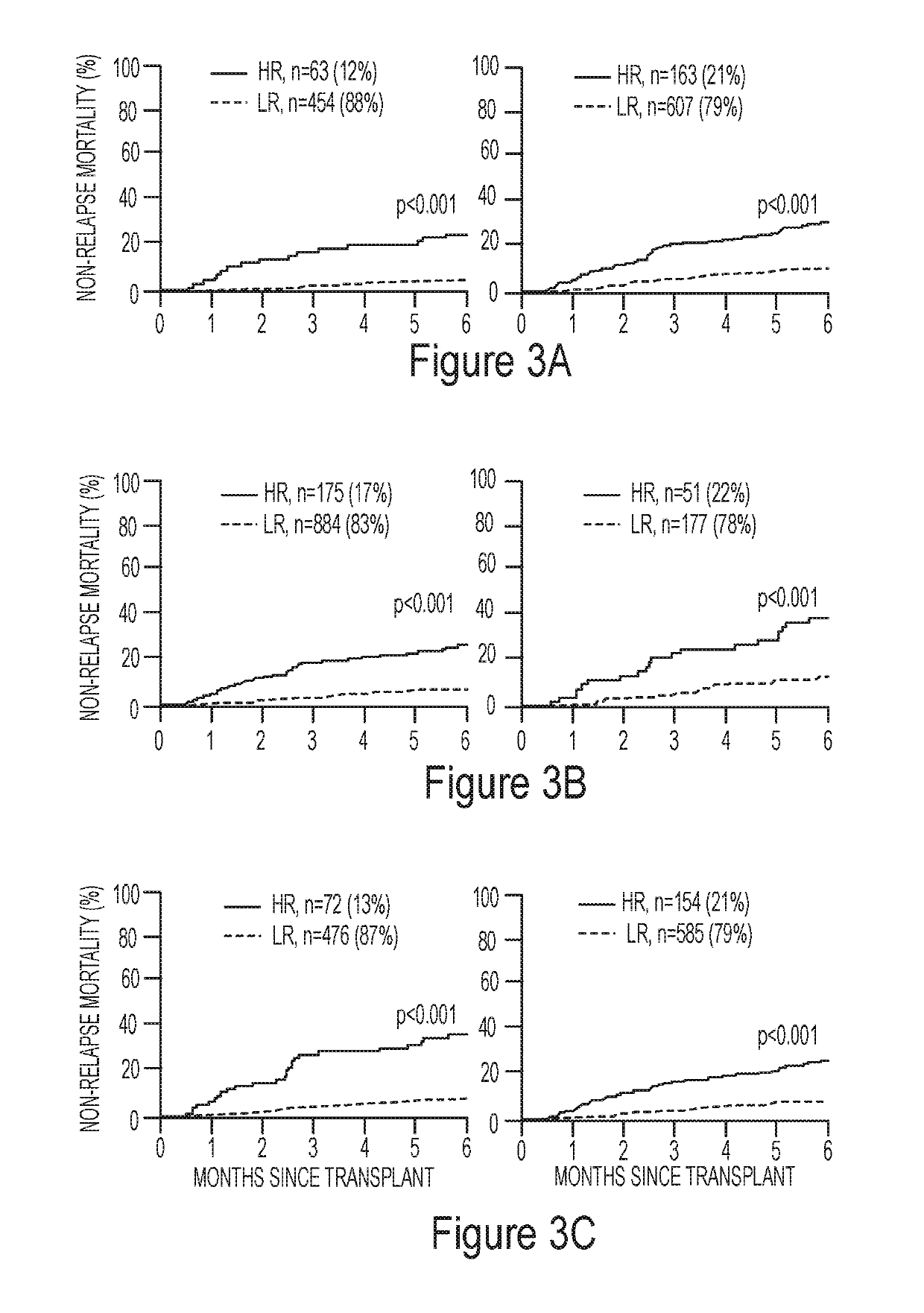Method of predicting graft versus host disease
a technology of host disease and graft, applied in the field of predicting graft versus host disease, can solve the problems of high risk of high-dose systemic steroid therapy, common diagnostic dilemma, and inability to consistently correlate histologic severity on biopsy with clinical outcom
- Summary
- Abstract
- Description
- Claims
- Application Information
AI Technical Summary
Benefits of technology
Problems solved by technology
Method used
Image
Examples
example 1
Development of Model
Methods
Study Design and Oversight
[0514]Patients from 11 centers (Table 1) in the Mount Sinai Acute GVHD International Consortium (MAGIC) underwent first allogeneic HCT from January 2005 to June 2015 and provided blood samples for a biorepository 7±3 days after HCT (FIG. 1). The institutional review boards at each of the 11 participating centers approved this study. Patient samples from the two largest contributing centers, the University of Michigan, Ann Arbor, Mich., USA (n=642) and the University of Regensburg, Germany (n=287) were combined and were then randomly assigned to a training (n=620) and test (n=309) set, conditional to similar ratios of patients from each center, median HCT dates, and overall 6-month non-relapse mortality. An independent group of 358 patients from the nine other MAGIC centers constituted the validation set (Table 2).
TABLE 1Patient Characteristics (n = 1287).TrainingTest setValidation setCharacteristicset (N = 620)(N = 309)(N = 358)Me...
example 2
Multiple Timepoints Improve Accuracy of Model
[0528]The inventors next determined whether repeat testing of biomarkers on day +14 post-bone marrow transplant could increase the sensitivity of the algorithm for lethal GVHD described herein.
[0529]Graft-versus-host disease (GVHD) is the leading cause of non-relapse mortality (NRM) in allogeneic bone marrow transplant (BMT) patients. The median onset of GVHD is 28 days after BMT. As demonstrated herein, the inventors have developed and validated an algorithm using two serum biomarkers (ST2 and REG3α) to stratify patients on day +7 after BMT into low risk (LR) and high risk (HR) groups for 6 month NRM. Identification of high risk patients by this blood test prior to the development of symptoms could allow for intervention with known and / or novel therapies designed to pre-empt lethal GVHD.
[0530]It was hypothesized that repeating the test one week closer to the development of GVHD (day +14) in patients initially categorized as low risk (LR)...
example 3
Testing the Model in Treatment Resistant Patients
[0539]Acute graft versus host disease (GVHD) is generally treated with systemic corticosteroid immunosuppression. Clinical response after one week of therapy often guides further treatment decisions, but long-term outcomes can vary widely between centers and more accurate predictive methods tests to predict long-term outcomes are urgently needed.
[0540]The inventors analyzed clinical data and blood samples taken after one week of systemic treatment for GVHD from 507 patients in the Mount Sinai Acute GVHD International Consortium (MAGIC), dividing them into test (n=236) and two validation cohorts separated in time (n=142 and 129, respectively).
[0541]Initial response to systemic steroids correlated with response at four weeks, one-year non-relapse mortality (NRM) and overall survival (OS). As shown herein, the described algorithm using two biomarkers (ST2 and REG3α) consistently separated patients steroid resistant patients into two grou...
PUM
| Property | Measurement | Unit |
|---|---|---|
| Time | aaaaa | aaaaa |
| Time | aaaaa | aaaaa |
| Time | aaaaa | aaaaa |
Abstract
Description
Claims
Application Information
 Login to View More
Login to View More - R&D
- Intellectual Property
- Life Sciences
- Materials
- Tech Scout
- Unparalleled Data Quality
- Higher Quality Content
- 60% Fewer Hallucinations
Browse by: Latest US Patents, China's latest patents, Technical Efficacy Thesaurus, Application Domain, Technology Topic, Popular Technical Reports.
© 2025 PatSnap. All rights reserved.Legal|Privacy policy|Modern Slavery Act Transparency Statement|Sitemap|About US| Contact US: help@patsnap.com



